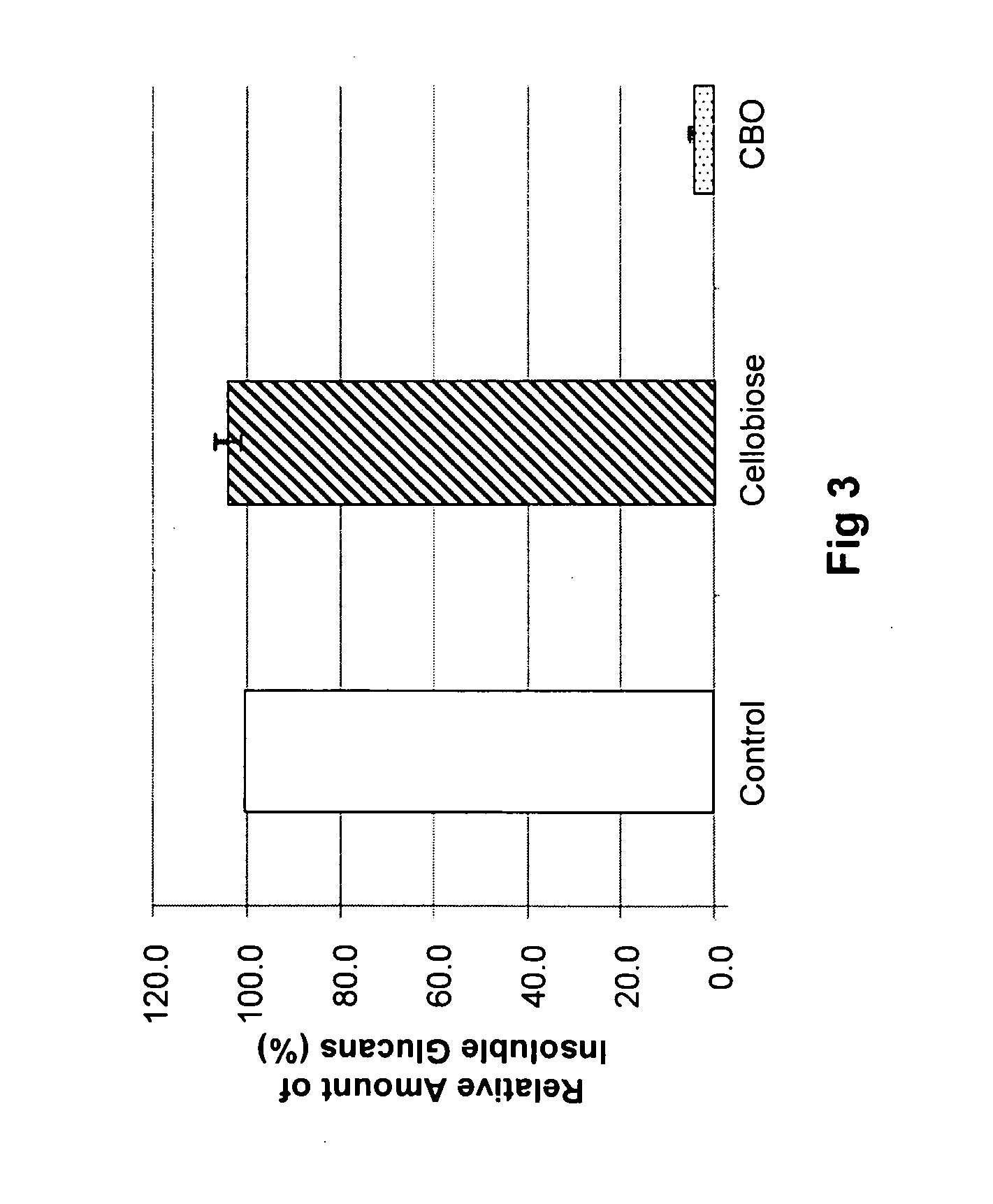Antifungal and Anti-Cariogenic Cellobio-Oligosaccharides Produced by Dextransucrase
- Summary
- Abstract
- Description
- Claims
- Application Information
AI Technical Summary
Benefits of technology
Problems solved by technology
Method used
Image
Examples
example 1
Production and Characterization of the Produced Cellobio-Oligosaccharides
[0030]Production of Dextransucrase: Leuconostoc mesenteroides B-512 FMCM, a constitutive mutant from the parent B512 F for dextransucrase production, was obtained from Dr. Doman Kim (Chonnam National University, Gwangju, South Korea; and as described in Kim and Kim, 1999). The culture was grown at 30° C. in LM medium [0.5% (w / v) yeast extract, 0.5% (w / v) peptone, 2% (w / v) K2HPO4, 0.02% (w / v) MgSO4.7H2O, 0.001% (w / v) NaCl, 0.001% (w / v) FeSO4.7H2O, 0.001% (w / v) MnSO4.H2O, 0.013% (w / v) CaCl2.2H2O] containing 2% glucose or 2% sucrose. The culture could also be maintained on glucose-LM medium containing 2% glucose and 1.5% agar at 4° C., and transferred biweekly. For growth measurement, samples of 5 ml were taken at various intervals for 48 h. Bacterial growth was measured at 660 nm in a spectrophotometer using a 1 cm optical cuvette, and pH was measured directly. The source of the chemicals and other agents used in...
example 2
Cellobio-Oligosaccharides as Inhibitors of Cariogenicity
[0044]Isolation of Oral Bacteria and Production of Mutansucrase: Oral bacteria were collected by a cotton swab from human teeth and streaked onto a brain heart infusion (BHI) agar containing 4% sucrose. The culture was grown at 37° C. until visible colonies of Streptococcus mutans and S. sorbrinus appeared. The colonies were grown in 1 L BHI at 37° C. with shaking at 150 rpm for 24-36 h to induce production of mutansucrase secreted outside the cell membrane. After incubation, the culture was harvested by centrifugation, and the supernatant with the mutansucrase was concentrated to 100 ml using a 30 K cut-off membrane filter. One unit of mutansucrase in the concentrated supernatant was defined as the amount of enzyme that catalyzes the formation of 1 μmol of fructose per minute at 37° C., pH 7.0, from 100 mM sucrose.
[0045]Inhibition of Insoluble Glucan Synthesis: The inhibition of CBO on the synthesis of water insoluble glucans ...
example 3
Cellobio-Oligosaccharides as Inhibitors of Fungal Growth
[0048]Collection and Growth of Aspergillus: A. terreus, ATCC No. 20514 (American Type Culture Collection, Manassas, Va.), was maintained on potato dextrose agar (PDA) medium for 5 to 7 days at 28° C. Conidia were collected with a cotton swab and suspended in 0.9% NaCl solution with 0.05% Tween 20. The heavy particles were allowed to settle for 2 h in cold solution. The viability was confirmed by plating serial dilutions onto PDA plates. For determination of the morphological changes, 2.5×104 conidia were inoculated into 2.9 ml of potato dextrose broth (PDB) with CBO and incubated for 10 days at 28° C. In this experiment and those following, CBO refers to the mixture of cellobio-oligosaccharides as described above in Example 1 which contains a majority of trisaccharides (>60%).
[0049]Inhibition of (1,3)-β-D-Glucan Synthase: For glucan synthase production, 4.5×108 conidia were inoculated into 500 ml of YME medium (0.4% yeast extra...
PUM
| Property | Measurement | Unit |
|---|---|---|
| Volume | aaaaa | aaaaa |
| Volume | aaaaa | aaaaa |
| Volume | aaaaa | aaaaa |
Abstract
Description
Claims
Application Information
 Login to View More
Login to View More - R&D
- Intellectual Property
- Life Sciences
- Materials
- Tech Scout
- Unparalleled Data Quality
- Higher Quality Content
- 60% Fewer Hallucinations
Browse by: Latest US Patents, China's latest patents, Technical Efficacy Thesaurus, Application Domain, Technology Topic, Popular Technical Reports.
© 2025 PatSnap. All rights reserved.Legal|Privacy policy|Modern Slavery Act Transparency Statement|Sitemap|About US| Contact US: help@patsnap.com



